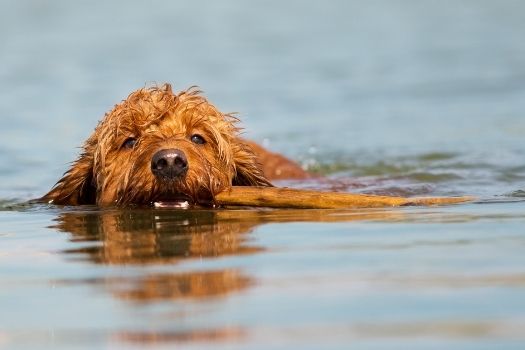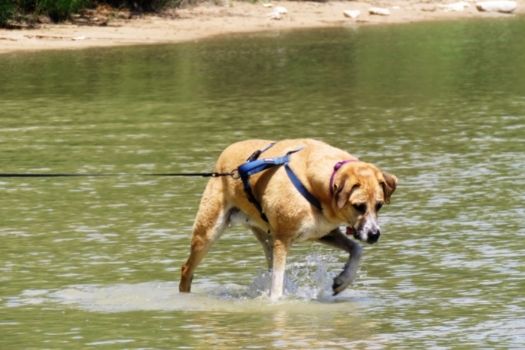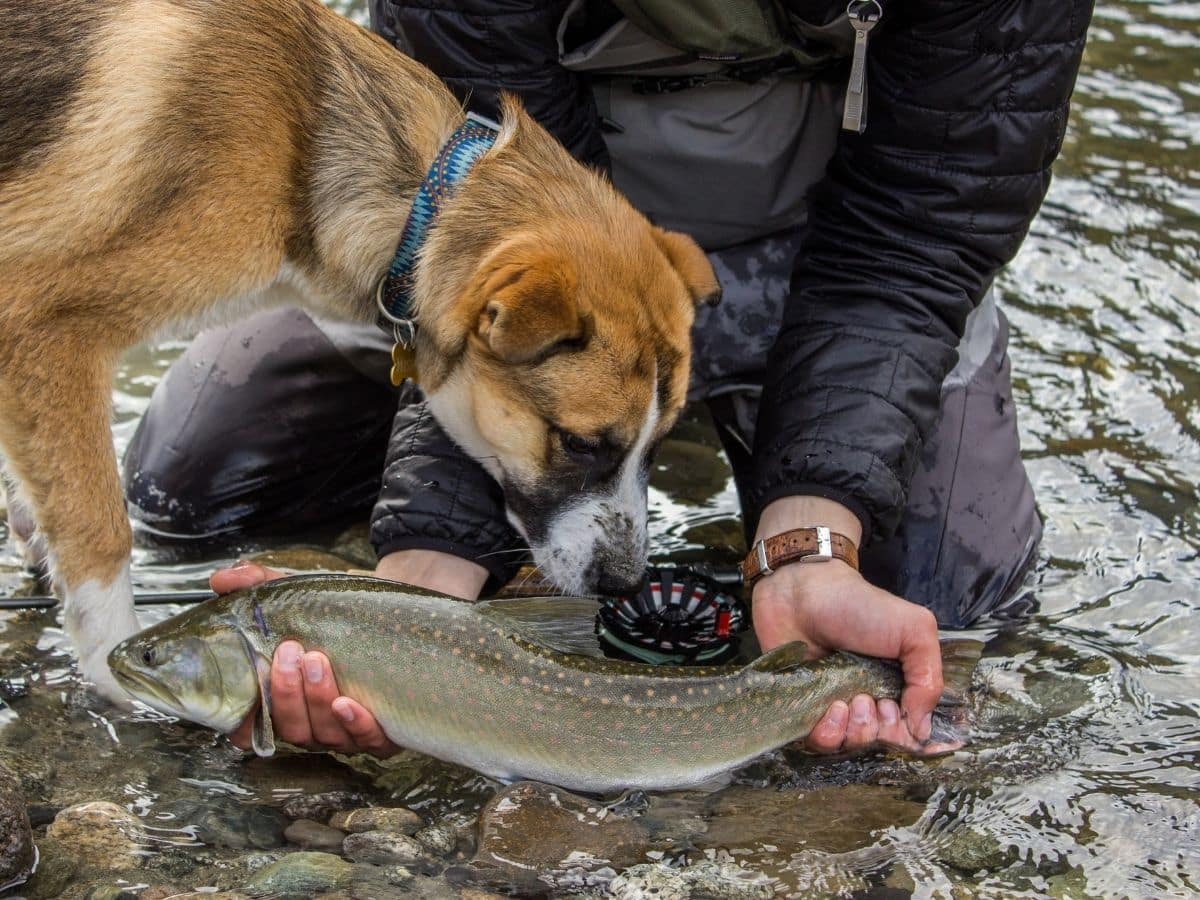If you love to fish, a loyal four-legged companion can turn a fun fishing trip into a perfect, memorable day out on the water.
Goldendoodles are friendly, intelligent, highly trainable, and they love to spend time in the outdoors. So, one of these pups could make the ideal furry fisherman’s friend.
Here are seven handy tips for bringing your dog fishing.
Tips When Fishing With Your Dog
1. Pick Your Fishing Spot Carefully
When you’re on a fishing trip, you want to concentrate on landing fat rainbow trout, record-breaking carp, bass, or crappie, not keeping an eye on your dog!
You should train your pet to be obedient and not wander too far, but how many dogs always do that? For that reason, you want to choose a fishing spot that’s safe and suitable for both of you.
Roads
If you’re fishing from the bank, choose a spot that’s well away from busy roads. You probably won’t have your dog leashed, so you need somewhere quiet and away from traffic where your dog can wander without you having to take your eyes off the water to watch your pet.
River Crossings
Unless you intend to remain on the same side of the river all day, you need to consider the suitability of river crossings for your dog.
For example, even small rapids can be too much for some dogs to cope with, so it’s better to pick a shallow spot or a place to fish where you don’t need to cross at all.
Busy Spots
Even if you have an obedient dog, choosing a spot where you will be shoulder to shoulder with other anglers might not be ideal. Some folks don’t like dogs, so choosing a quieter area with fewer people around might be the better option.
2. Can Your Dog Swim?

Many dog breeds enjoy swimming, while some hate getting their feet wet.
For example, Goldendoodles have Golden retriever and Poodle genes in their makeup. Both of those breeds were originally bred to work as bird dogs, retrieving shot ducks and other waterfowl from marshes and bodies of water. Consequently, every generation of Goldendoodle, including F1BB and F2 dogs, are natural swimmers that love to spend time in the water.
But even a tiny stream can be a potential death trap for a dog that isn’t a good swimmer. So, always know whether your pup can swim before you take him fishing with you.
Likewise, if you’re fishing from the water, you need a dog that can swim. A pet buoyancy aid is necessary even if your dog is a water baby, especially if the water is deep and the current is strong.
3. Safety First
As every angler knows, it’s all too easy to get hooked during a fly cast. Always check where your dog is before you cast a line, especially when backcasting. It’s a good idea to pinch your barbs when Fido is coming with you. That way, in the event of an accident, the hook will slide out easily rather than get stuck fast.
Keep your tackle boxes closed with all hooks and other pieces of kit stowed safely inside, and don’t leave flies on the ground where your dog can reach them.
4. Provide Water For Your Dog
Dogs can become dehydrated pretty quickly, especially on warm days. So, make sure that you take a supply of freshwater with you for your dog.
Also, if you go fishing during the summertime, your dog will need some shade to sit in so that he doesn’t overheat.
5. Provide Comfort Breaks For Your Dog
Remember that your dog needs bathroom breaks just like you do!
If you’re fishing from the bank, that’s not a problem if your pet is wandering around off-leash. However, if you’re on a boat, you’ll need to let your dog off your vessel a couple of times during the day so that he can relieve himself. If you’re going somewhere busy where people walk, take some poop bags with you and clean up after your dog.
6. Take A Leash

If you’re fishing from a boat, you probably won’t need to use a leash much, as your pet will be free to roam.
However, it’s worth noting that many State Parks and wilderness areas popular with fishers have strict leash laws for dogs. If you’re caught with your dog running loose when he shouldn’t be, you could be on the wrong end of a hefty fine. So, double-check the laws surrounding dogs before you set off, and always take a leash with you just in case you need one.
A leash is also essential in an emergency when you don’t want a frightened dog running loose. You’ll also need a leash to keep Fido in check and secured to the dock while you unload your boat.
7. Treats!
When you’ve landed the Big One, you might reward yourself with a couple of beers. But what about your dog?
Treats are essential for rewarding your dog for his good behavior while you’re on your fishing trip. Goldendoodles are especially fond of food rewards, and positive reinforcement methods are especially effective when training a Doodle for life as your fishing companion.
If your canine companion knows that he will be rewarded with treats when obeying your commands, he will be more likely to pay attention and obey you. Treats can also be used as an effective distraction. For example, if your dog is nervous around water or isn’t happy with being left ashore while you wade out into the water to fish, offering your pet, a few treats can help relax him and ease the pain of being left alone for a while.
In Conclusion
Taking your dog with you when you go on fishing trips can be a fun and rewarding experience. However, you need to make sure that your dog is obedient to a few basic commands so that you can concentrate on landing the catch of the day rather than struggling to control Fido.
Also, your canine companion should be able to swim, and if you’re fishing from the water, your dog must be kitted out in a buoyancy aid in case he falls (or jumps!) overboard. Finally, keep fishing hooks well out of your dog’s reach, and always choose somewhere quiet and away from heavy traffic if your pet is going to be off-leash.

